Help:Content translation/Starting/pl
| Uwaga: Jeżeli edytujesz tę stronę, to umieszczając na niej treści wyrażasz nieodwołalną zgodę na udostępnianie Twojego materiału na podstawie wolnej licencji CC0. Aby uzyskać więcej informacji, przeczytaj Strony Pomocy w Domenie Publicznej. |
There are different ways in which you can start a translation. One way may be preferred over another depending on whether you already have an article to translate in mind, you want to discover new possibilities for translation, or you just want to continue an existing translation that you started earlier.
Note that Content translation is still in beta, and the entry points described below are only available when you enable this beta feature and are logged-in.
Contributions page entry points

Your contributions page is a main entry point to start a translation. You can access this page from the "Contributions" link that appears next to your user name on top. The page includes quick access to frequent ways to contribute, including the access to translation.
This is a persistent access point to the translation dashboard where you can start a translation anytime.
Contributions menu

For a quick convenient access, the options provided to start a translation on your contributions page are also surfaced on a menu when you hover over the "Contributions" link. In this way, the number of steps to access your translations are reduced for devices with pointing devices supporting hover.
Grey language links
When you read content in one language, you may wonder whether such content is available in other languages you know in order to create it if it's missing. For those cases, surfacing the languages in which the content is missing and you can contribute to can be convenient.
Grey interlanguage links are shown in the usual list of languages that you can find on the sidebar of a Wikipedia page when it is available in multiple languages. Unlike the regular language links, the grey links represent missing content that you can help create.
Grey links are only shown for languages you have accessed before, to avoid crowding the list of languages with missing languages that you may not be able to translate into.
Accessing a grey language will show a dialog where you can provide the title for your translation and start it right away.
Translation dashboard

The translation dashboard can be accessed directly, or by using some of the entry points described above. It is the central place where you can manage your translations, start new ones, explore suggestions for articles to translate, and check your translation progress.
Sugestie
The translations dashboard includes a suggestions tab where you can access a list of suggestions. This is convenient when you don't have a clear idea of what to translate and you want to look for an interesting topic that is missing in your language.
The suggestions provided combine personalised suggestions based on previous translations you have made as well as general suggestions based on the languages you selected. The option to refresh the suggestion allows to get suggestions based on a different criteria.
Invites to translate
The option to translate is also provided at different points where it may be relevant to editors as they participate in other contribution activities. The table below extracts from the Entry Point catalog the different opportunities specifically about translation. The notes include links to the Phabricator tickets and notes on the instrumentation identifiers.
| Entry Point Name | Contribution Type | Platform(s) | Screenshot(s) | Performance | Availability | Notes |
|---|---|---|---|---|---|---|
| New Translation | Translate an article from one language to another language | Web (desktop) | 
|
|||
| Translation as alternative to create article from scratch | Translation (new article) | Web (desktop and mobile) |  
|
If there is a relevant suggestion based on the title it is shown in the invite. Otherwise, the invite is shown only once for the user. | "newbytranslation" (event source: "invite_new_article_creation") | |
| Review recent translations | Proofreading, and Translation (expand) | Web (mobile) |   
|
Research suggests that users can easily and quickly discover it and interpret as a signal that some action was needed for the article [1] | Logged-in users on mobile.
Articles published as a translation in the last 10 days, with less than 5 edits. The article has no other notices (to give priority to community added ones), and is not a redirect. |
"mfrecenttranslation" (event source: "recent_translation") |
| Translate a section the user recently edited in another language | Translation (expand) | Web (mobile) | 
|
On mobile, the user is in a page that they have edited in another language recently in their 10 latest significant edits (+500 bytes or more) for a section missing in the current language. | "mfrecentedit" (event source: "recent_edit") | |
| Surface missing languages to translate | Translation (new article) | Web (desktop and mobile) |  
|
Articles missing on a language relevant to the user. | "mffrequentlanguages" (event source: "frequent_languages") | |
| Search for missing language to translate | Translation (new article) | Web (mobile) | 
|
Research shows that searching for the availability of an article in a given language is often an initial step in the translation process.[2][3] | Logged-in users on mobile.
Searching for a language the article is not available in (and mobile translation is supported). |
"mflanguagesearcher" (event source: "content_language_selector") |
| More options from language selector | Translation (new article) | Web (desktop) |  
|
The Language selector provides access to additional options from the bottom corner. Logged-in users on desktop where Content Translation is available have an option to translate the page into more languages. | T289840 | |
| Post-publish follow-up | Translation (expand), and Proofreading (secondary) | Web (mobile) | 
|
Logged-in user after publishing a translation for an article/section on mobile. | (event source: "followup_after_publishing") |
